Dalmatian Pelican Profile
The dalmatian pelican is a huge bird that is the largest of all the pelican species. Considered to be one of the biggest freshwater birds in the world, the Dalmatian pelican boasts a wingspan of over 2 metres and can weigh up to 15 kilograms.
Their name derives from their supposed origin in Dalmatia, Croatia, although they are found across large parts of Europe and Asia. Dalmatian pelicans have a mostly grey-white plumage with black tipped wings and huge bills.
At a length over 40cm, they have one of the longest bills of any bird species and during the breeding season, the lower bill or pouch turns deep orange to red.
Dalmatian pelicans are a predominantly freshwater dwelling bird, although they are also frequently seen on estuaries and river deltas. These pelicans particularly thrive in undisturbed, natural wetlands which provide an ample food source, as well as vegetation cover.
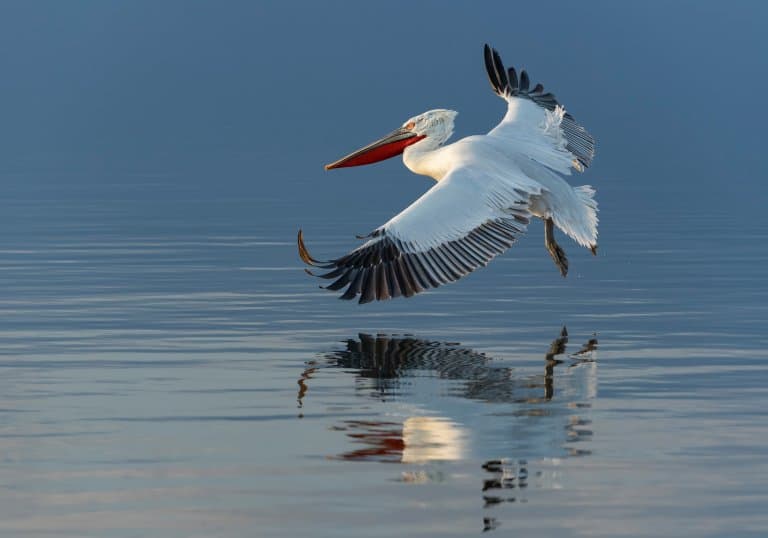
Dalmatian Pelican Facts Overview
| Habitat: | Freshwater wetlands, lakes, rivers and estuaries |
| Location: | Location: Europe and Asia |
| Lifespan: | Around 35 years in the wild |
| Size: | Length up to 1.8m, wingspan 3.5m |
| Weight: | Around 11kg |
| Colour/Appearance: | Grayish wings tipped with black. Lighter white-grey plumage on chest, huge yellowish bill and disheveled crest feathers on head |
| Diet: | Mainly fish, but will opportunistically take amphibians, reptiles and crustaceans |
| Predators: | Eggs and chicks taken by animals, such as foxes, and wild boar. Adults occasionally preyed upon by foxes and wild cats |
| Top Speed: | Around 45km/h |
| Number of Species: | 1 |
| Threats: | Loss and disturbance of nesting sites, hunting, overfishing and pollution |
| Conservation status: | Vulnerable |
Although this species migrates in some colder regions, they tend to only seasonally migrate and settle on the nearest ice-free bodies of water. During the breeding season the Dalmatian pelican requires lakes or wetlands with floating grass and reeds to nest in and is particularly vulnerable to human disturbance in those areas.
Like most pelican species, the Dalmatian pelican lives on a diet that consists mainly of fish such as carp, mullet and eels. However, they are highly opportunistic feeders and will also take frogs, lizards, crabs and lobsters, usually inadvertently when scooping up fish.
Dalmatian pelicans form monogamous bonds during the breeding season and choose a different mate the following year. Even outside of the breeding season, Dalmatian pelicans are rarely seen alone and roost together in large flocks.
When fishing for food, Dalmatian pelicans will usually work in groups to force fish into larger shoals, thus making it easier to scoop up more fish in one go. Unlike several other pelican species, the Dalmatian pelican frequently hunts in deeper water, where larger fish are more commonly found.
As well as fishing in groups, these pelicans will also fish with a different bird species, such as the cormorant. By diving deep for fish, the cormorants bring fish closer to the surface where the pelicans can scoop them up. Fish that escape the pelicans them become easy prey for other diving cormorants.
Breeding colonies choose bodies of water that contain abundant prey as well as vegetation on which to build nests. Nests are built on floating reeds and grass and are gradually held together by the pelicans’ droppings. Male Dalmatian pelicans will bring materials to help build the nest while females are responsible for the actual construction. Females will lay between 1 to 2 eggs and when the chicks hatch, both parents will bring food back for the chicks to feed on.
Despite having a relatively large distribution across Europe and Asia, the global population of the Dalmatian pelican has steadily been decreasing.
As such large birds, they require appropriate water sources with abundant prey and man-made developments have reduced much of their hunting grounds. More detrimental to their population however is disturbance and loss of nesting grounds as a result of wetland drainage and human encroachment.
However conservation efforts aim to protect breeding and feeding sites and educate people on responsible wildlife tourism and the benefits the Dalmatian pelican provide to the ecosystem and mankind alike.
The presence of the Dalmatian pelican in an area indicates a healthy ecosystem which in turn means more fish for fisherman and a more robust food chain.
Interesting Dalmatian Pelican Facts
1. Dalmatian pelicans are the largest of all pelican species
With a wingspan over 2m and weighing up to 15kg they are one of the biggest flying birds in the world. As they are massive birds, Dalmatian pelicans spend more time on the water than in the air.
The effort to lift their huge bulk into the air requires a lot of energy and pelicans have evolved several features to make the process more energy efficient.
Like all birds they have partly hollow bones that reduces their weight when flying. 1
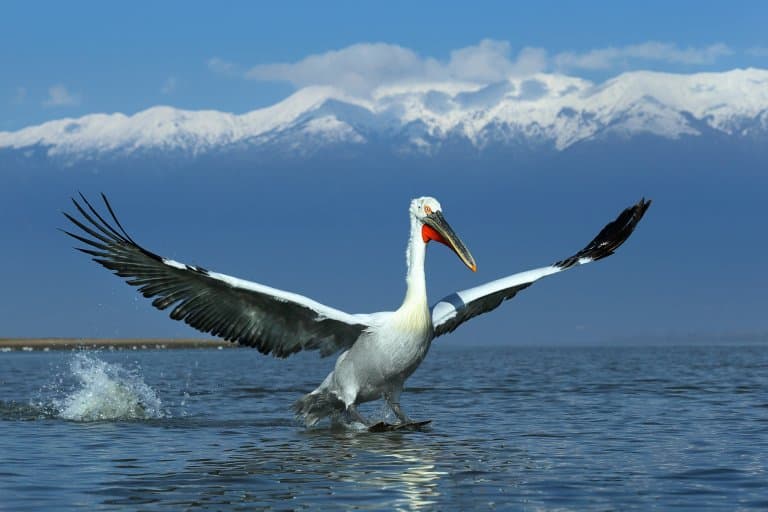
2. They are not strictly coloured black and white, despite their name
The name “Dalmatian” actually refers to their supposed origin in Dalmatia, Croatia.
Dalmatian pelicans have a mostly grey-white plumage with black tipped wings and huge orange and yellow bills.2
3. They have huge pouches called a ‘gular’ pouch
Their throat pouch can hold over 11 litres of water, more than three times their stomach can hold.
Using their huge bill and bill pouch, Dalmatian pelicans scoop up fish and water all at once, then tip their heads forward to drain the water out. Very rarely will pelicans travel with food in their pouch, rather they simply lift their heads back and swallow the fish whole.
Due to the massive size of their bills, Dalmatian pelicans are capable of swallowing relatively big fish in a single gulp. 3
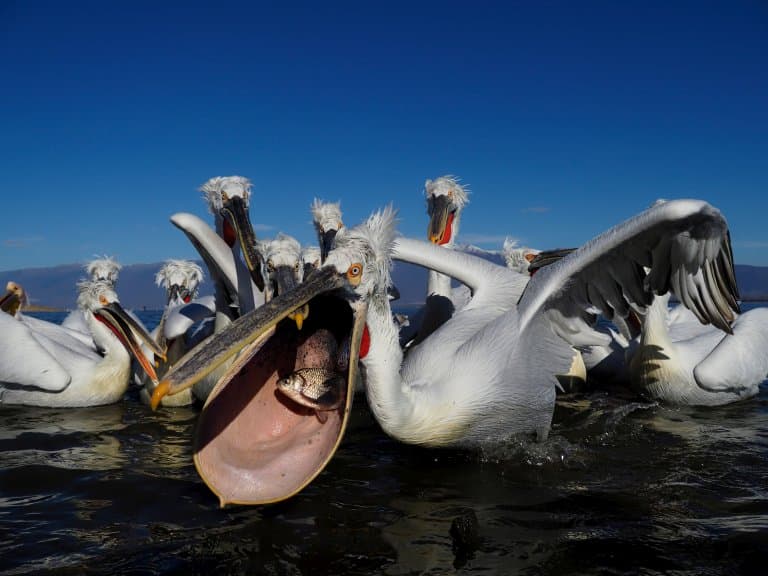
4. Dalmatian pelicans are one of the biggest flying birds on Earth
Along with the albatross and the great white pelican, these birds have one of the biggest wingspans of any bird species – over 2m!
Pelicans also have big chest muscles that allow them to beat their huge wings. When taking off from water, the Dalmatian pelican runs along the water surface while flapping its wings to gain enough speed or traction to become airborne. 4
5. Dalmatian pelicans are highly sociable animals
Dalmatian pelicans spend the majority of their time on water and only come to land to breed, rest or preen their feathers. The Dalmatian pelican is an especially social bird and is often seen in flocks consisting of dozens of individuals.
When breeding, this species forms colonies that can number over 1,000 birds, however larger colonies are becoming less common. 5
6. When flying, Dalmatian pelicans hold their head and neck back
By tucking their huge bill against their neck and hold their head back between their shoulders, pelicans reduce air resistance when in flight.
When in the air, they sometimes fly in a V formation which reduces wind resistance and means the pelicans can fly further using less energy.
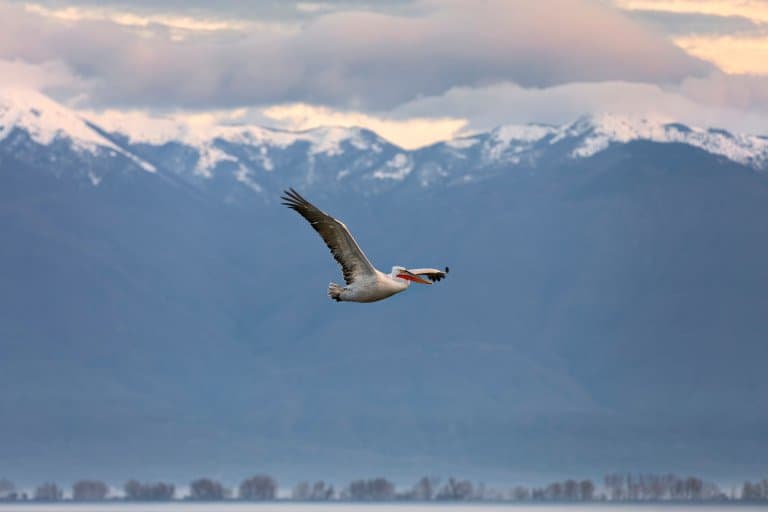
7. They are sometimes seen flying with other bird species
Cormorants, flamingoes and other pelican species may mix with Dalmatian pelican flocks as they search for suitable feeding sites. 6
8. Both male and female Dalmatian pelicans care for their young
While one parent stays with the chicks, the other searches for food and upon their return, the other parent then goes out fishing.
After around 4 months the chicks become independent and leave the breeding site, but will usually remain within their birth flock or colony.
9. Their nests are held together with algae and droppings
Female Dalmatian pelicans arrange sticks and reeds brought by the male to create floating nests.
10. Their throat pouches rarely transport caught fish
Even when returning to chicks with food, Dalmatian pelicans will regurgitate their meal rather than carry whole fish in their pouch.
11. They live on a diet almost entirely consisting of fish
Although they may inadvertently catch frogs and crabs, Dalmatian pelicans almost exclusively hunt for fish.
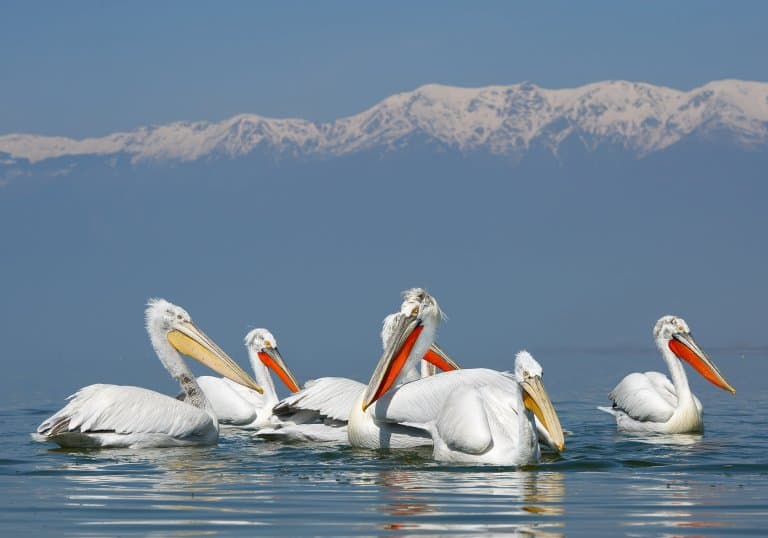
12. Dalmatian pelicans are not known as sleek, well groomed pelicans
With upswept feathers on top of their head and a rather disheveled, greyish plumage, they differ very much from species such as the more sleek and colourful Australian pelican. 7
Dalmatian Pelican Fact-File Summary
Scientific Classification
| Kingdom: | Animalia |
| Phylum: | Chordata |
| Class: | Aves |
| Order: | Pelecaniformes |
| Family: | Pelecanidae |
| Genus | Pelecanus |
| Species | Pelecanus Crispus |
Fact Sources & References
- Crivelli Alain (1997), “Pelecanus crispus Dalmatian Pelican”, Research Gate.
- “International Single Species Action Plan for the Conservation of the Dalmatian Pelican Pelecanus crispus”, Convention on the Conservation of Migratory Species of Wild Animals (CMS).
- “Pelican”, San Diego Wildlife Alliance.
- “Dalmatian Pelican Pelecanus crispus”, eBird.
- “The Dalmatian Pelican in Britain”, British Birds.
- Gordon Ramel (2023), “Dalmation Pelicans”, Earth Life.
- ED BluePlanet (2020), “All About the Dalmatian Pelican: Weird and Wonderful Facts”, Blue Planet Aquarium.
